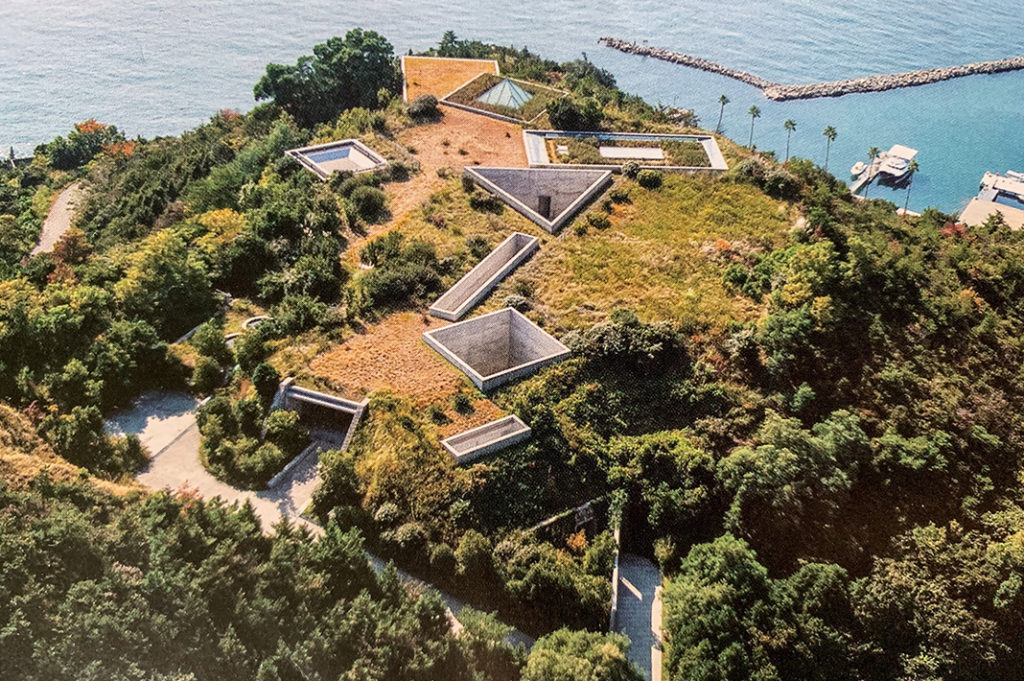A bird flying overhead might notice a few geometric shapes at grass level, but even the most slightly trained eye can find so much more to appreciate at Naoshima’s Chichu Art Museum. Located on the coast of the Seto Inland Sea, this partially underground museum has been designed to not disturb the dramatic coastal landscape. Tadao Ando’s semi-subterranean design is a work of art in itself; towering concrete hallways open to the elements, criss-crossing stairways like something out of an Escher, deliberately disorienting angles and sharp edges. From above, the museum’s connected spaces appear as a cluster of disjointed concrete outlines.

A Quiet, Reflective Space
Once inside, the first thing you’ll notice is how quiet it is—this is by design of course. The written guide given upon entry outlines the rules—no eating, drinking, smoking, touching artworks and a plea to keep volume to a minimum in order to create a peaceful environment. At times it’s almost a game to see how silently you can tread through the echoey concrete spaces. This makes such a difference to the experience; there is less distraction and more respect.
Even though the space is pared back concrete, glass, steel and wood, it’s light, bright and peaceful. And for an underground museum, that’s no small feat. In fact, many of the spaces are lit only by natural sources. Skylights and openings provide plenty of illumination, even on overcast days. This essentially means that the works appear differently depending on the time of day, weather and season.
A Permanent Display
The permanent display at Chichu Art Museum includes works by Claude Monet, Walter De Maria and James Turrell. The Monet room features five paintings from the ‘Waterlily’ series. The room is naturally lit; even simply exiting and re-entering has the effect of changing the appearance of the works.
De Maria’s Underground Space Chapel
One of the most impressive pieces is Walter De Maria’s ‘Time / Timeless / No Time’. As you step into the large underground concrete space, you are faced with an astounding sight. Giant concrete steps ascend ahead of you, stretching from one wall to the other. Half way up sits a large 2.2m diameter granite ball. Then, lining the walls are geometric wooden poles, painted gold and positioned at different heights. The space is lit only by skylights so as the light changes throughout the day, different angles of the wood gleam. The room is so arresting at first glance, that after we had finished exploring the room, we had to step back in to get the full wow-factor effect one last time.
James Turrell
The works of James Turrell, centred around light and space, fit in so perfectly here. The first, ‘Afrum, Pale Blue’, is a startling pale blue optical illusion. A nice pre-cursor to his bigger works.
Next, the ‘Open Sky’ installation. This square courtyard features towering concrete walls and a wrap-around (heated) concrete bench to sit on. The roof is open in the middle and the backrests are slanted for relaxed views of the sky. The weather during our visit was overcast, glary and drizzly, so it took a moment for us to realise that we were looking at the sky and not a bright LED light / ‘rain room’. The sound of the falling rain was so meditative.
The ‘Open Sky’ space is also used on Friday and Saturday nights for an evening display. It can sell out quickly so jump online to reserve your spot up to 3 months in advance.
My favourite piece though, was James Turrell’s ‘Open Field’. Shoes have to come off for this one, and you enter the space as a small group. Part light show, part optical illusion, it feels like entering through the TV screen. I implore you to try. Even non-arty types can appreciate this one.
If you only have limited time on Naoshima, put Chichu Art Museum at the top of your list. Our group all agreed that it was the most impressive of all.
Before you go
Note that you will need to reserve ahead online for entry, we did it 35 minutes in advance with no issues. You then need to collect your tickets at the ticket office which is located a little further along the road from the entrance. Lockers are located just inside the entrance and require a ¥100 coin deposit. For rainy days, complimentary umbrellas are available at the outdoor sections. There is no photography allowed inside and you must keep noise to a minimum. There are two points when you must remove your shoes and wear the slippers provided—to view Monet’s works and to enter James Turrell’s ‘Open Field’.
Access
You can walk to Chichu Art Museum from Miyanoura port in 30 minutes. However, you will be walking along a windy road that goes uphill at times so be careful.
Though, if you have hired a bike the journey will be shorter. It’s also possible to catch the free Benesse shuttle bus which runs every thirty minutes around town.
Name: Chichu Art Museum
Address: 3449―1, Naoshima, Kagawa District, Kagawa 761-3110 (link)
Open: 10:00a.m. until 5:00p.m (Closed Mondays)
URL: http://benesse-artsite.jp/art/chichu.html
Post by Japan Journeys.